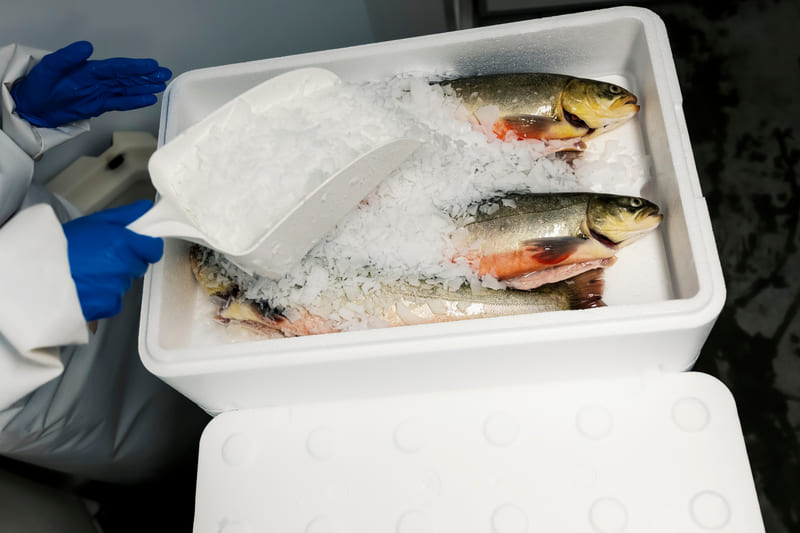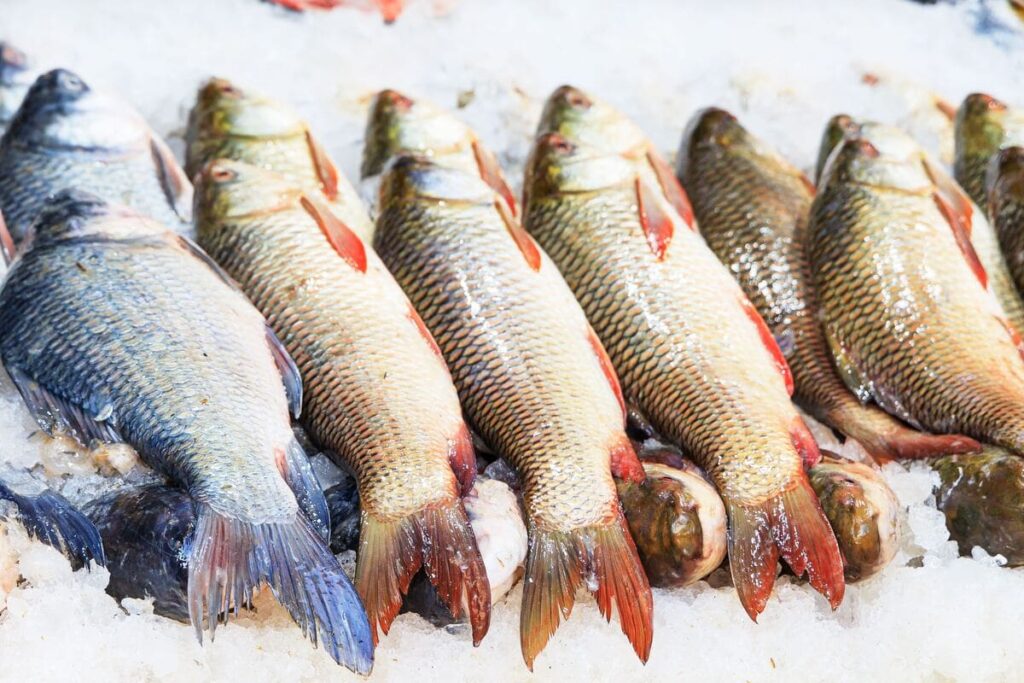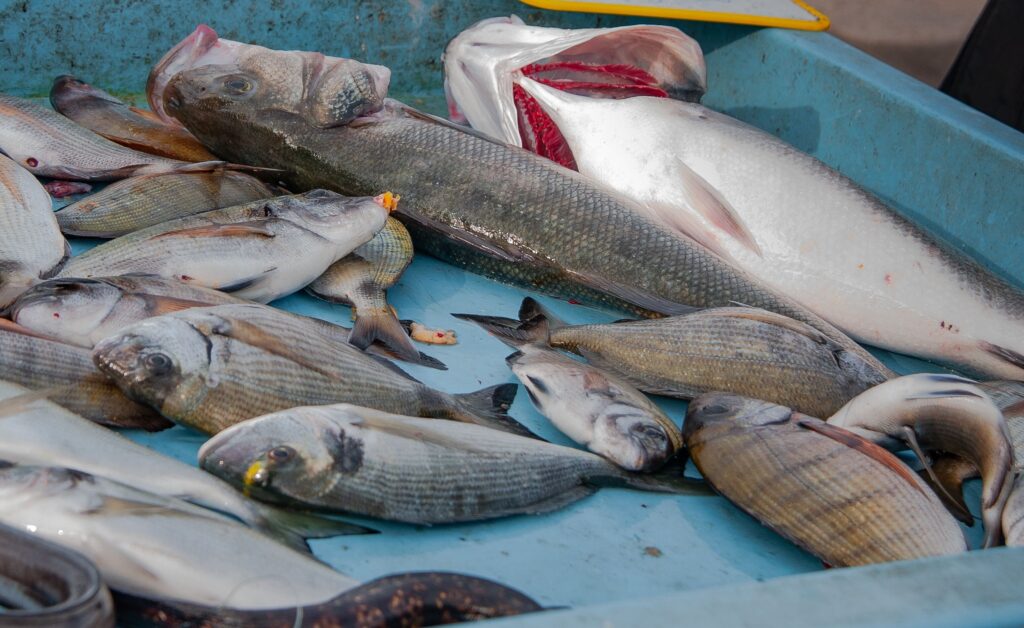How soon should fish be put on ice? This crucial question is often asked by professionals in the fishery, seafood distribution, and food processing industries. In this comprehensive blog post, we will delve into various aspects of properly handling and storing fish to ensure maximum freshness and quality.
We’ll discuss the importance of icing fish immediately to prevent bacteria growth and reduce spoilage risks. Additionally, we’ll explore humane stunning and bleeding techniques that can improve overall product quality.
Furthermore, you’ll learn about washing freshwater fish prior to icing for optimal conditions, extending shelf life with proper storage materials such as aluminum foil or polyvinylidene chloride (PVDC) film usage. We will also cover commercially frozen fish glazing processes along with their benefits and application techniques.
Last but not least, we will reveal seasonings that can help improve thawing times while preserving taste profiles. Finally, we’ll analyze factors impacting a fish’s shelf life including cleaning time significance and proper storage methods implementation. By understanding how soon should fish be put on ice among other best practices shared in this post, you’ll elevate your knowledge in maintaining peak freshness for your seafood products.
Importance of Icing Fish Immediately
Time is a crucial factor in preserving the freshness and quality of fish. Putting fish on ice as soon after being caught as possible helps prevent bacterial growth and premature spoilage, ensuring that your catch remains fresh and delicious for an extended period. In this section, we’ll explore the benefits of immediate icing and how it contributes to maintaining optimal seafood quality.
Preventing Bacterial Growth
The moment a fish leaves its natural habitat, bacteria begin to multiply on its surface. By icing your catch immediately, you slow down bacterial growth significantly, thus reducing the risk of foodborne illnesses. Additionally, rapid cooling helps maintain the texture and flavor profile that makes seafood such a sought-after delicacy.
Reducing the Risk of Spoilage
- Fish enzymes: Freshly caught fish contain enzymes that can cause spoilage if not promptly cooled down. Placing them on ice slows these enzymatic reactions considerably.
- Oxidation: Exposure to air leads to oxidation which affects both taste and appearance negatively. Immediate icing minimizes contact with oxygen while keeping your catch in pristine condition.
- Ambient temperature: High temperatures accelerate decomposition processes within fish tissue; therefore, quick chilling becomes essential when fishing in warmer climates or during summer months.
In conclusion, storing fish on ice as soon as possible after catching is crucial to maintaining its freshness and quality. Whether you plan to freeze fish or store it in an insulated cooler, immediate icing is the key to extending its shelf life. Don’t let your fish suffer from premature spoilage or bacterial growth – put fish directly into ice water or an ice-filled cooler with crushed ice. Whether you’re dealing with gutted fish or ungutted fish, lean fish or fatty fish, long fish or short fish, immediate icing is the best way to keep your fish fresh and delicious.
The importance of icing fish immediately cannot be overstated, as it helps to prevent the growth of bacteria and reduce spoilage. To ensure humane treatment, proper stunning and bleeding techniques should also be used when handling live fish.
Humane Stunning and Bleeding Techniques
Before you put fish on ice, it’s essential to stun them humanely and bleed them properly. This process not only shows respect for the catch but also helps preserve both flavor and texture by removing blood from the flesh that could otherwise cause spoilage or off-flavors during storage.
Methods for Stunning Fish
- Ikejime: A traditional Japanese method where a sharp spike is inserted into the brain of the fish, killing it instantly. Learn more about Ikejime in this informative article.
- Percussive stunning: A quick blow to the head with a blunt object renders the fish unconscious before death. Check out this helpful guide on how to perform percussive stunning correctly.
Proper Bleeding Techniques
- Gently hold your stunned fish upside down, making sure its gills are exposed.
- Cut through one side of its gill arches using a sharp knife or scissors without severing any major arteries or veins entirely – just enough so blood can flow freely outwards when pressure is applied gently around the area being cut open (this should take no longer than a few seconds).
Incorporating these humane methods ensures that you’re treating your catch with respect while also preserving its quality for consumption. Remember, the tastier your fish is going to be when it’s served up.
Humane stunning and bleeding techniques are essential for ensuring that the fish is killed in a humane manner, thus allowing for optimal quality of the final product. To further ensure optimal conditions, it is important to properly wash freshwater fish prior to icing.
Washing Freshwater Fish Prior to Icing
After stunning and bleeding your catch, it’s essential to give freshwater fish a thorough wash in cold water. Why, you ask? Well, this simple step helps remove any surface bacteria that may be lurking on the fish’s skin. By doing so, you’re not only ensuring cleanliness but also maintaining optimal conditions for keeping your freshly caught seafood at its peak quality throughout transportation from fisheries all the way onto consumers’ plates worldwide.
Removing Surface Bacteria
To effectively remove surface bacteria from your catch, gently scrub the fish with clean hands or a soft brush under running cold water. Make sure to pay special attention to areas like gills and crevices where bacteria can hide more easily. NOAA Fisheries recommends removing scales as well if you plan on consuming them.
Maintaining Optimal Conditions
- Cold Water: Always use cold water when washing your fish – warm or hot water could promote bacterial growth instead of preventing it.
- Air Circulation: After washing, place the cleaned fish in an insulated cooler filled with ice or flake ice machines provided by Hiceay (like their high-quality commercial flake ice machine). This will ensure proper air circulation around each piece while keeping them chilled during transport.
- Ice-to-Fish Ratio: Aim for a ratio of two parts ice to one part fish inside the cooler – this guarantees maximum freshness and quality throughout transportation.
It’s important to note that fish suffer from the same spoilage as any other perishable food item. Therefore, it’s crucial to store fish properly to maintain its freshness and shelf life. Here are some tips on how to store fish:

- Put Fish on Ice Directly: As soon as you catch fish, put it on ice directly. This will help preserve its freshness and quality.
- Use Crushed Ice: Crushed ice is better than blocked ice because it conforms to the shape of the fish and cools it faster.
- Store Fish in an Ice-Filled Cooler: If you’re not planning on freezing the fish, store it in an ice-filled cooler. Make sure to drain any excess water from the cooler as the ice melts and replace it with fresh ice as needed.
- Freeze Fish: If you’re not planning on consuming the fish within a few days, freeze it. Make sure to clean and gut the fish before freezing it. Lean fish can be stored for up to six months, while fatty fish can be stored for up to three months.
- Thaw Fish Properly: When you’re ready to use frozen fish, thaw it properly. The best way to do this is to place the fish in the refrigerator overnight. If you’re in a hurry, you can also thaw fish in cold water. Make sure to change the water every 30 minutes to prevent bacterial growth.
By following these tips, you can keep your fish fresh and of high quality for longer periods. Whether you’re storing fish or transporting it, it’s important to take the necessary steps to ensure that it remains fresh and safe to consume.
Washing freshwater fish prior to icing is essential for removing surface bacteria and maintaining optimal conditions. Additionally, proper storage materials such as aluminum foil wrapping technique or polyvinylidene chloride (PVDC) film can be used to extend the shelf life of the fish.
How Soon Should Fish Be Put on Ice?
As a fisherman, you know that the key to preserving the quality of your catch is to put it on ice as soon as possible. But how soon is soon enough? The answer may surprise you.
According to experts, fish should be put on ice within 30 minutes of being caught. This is especially important if you plan to store or transport the fish for any length of time. By putting the fish on ice quickly, you can slow down the growth of bacteria and other microorganisms that can cause the fish to spoil.

But putting fish on ice isn’t enough. You also need to make sure that you’re using the right kind of ice and storing the fish properly to extend its shelf life.
Using the Right Kind of Ice
Believe it or not, not all ice is created equal when it comes to storing fish. Here are some tips to keep in mind:
- Use clean, potable water to make your ice.
- Use ice made from a quality ice machine like those from Hiceay.
- Avoid using ice that has been sitting around for a long time or that has been exposed to air.
- Consider using flaked ice or ice water instead of whole ice cubes. This will help to cool the fish more quickly and evenly.
Storing Fish Properly

Once you have your ice, it’s time to store the fish. Here are some tips to keep in mind:
- Store fish in an insulated cooler with plenty of ice. The ideal temperature for storing fish is between 32 and 39 degrees Fahrenheit.
- If possible, store fish that has been gutted and cleaned. This will help to prevent the growth of bacteria and other microorganisms.
- If you must store ungutted fish, make sure to pack the cavity with ice to help keep it cool.
- Don’t put fish directly on top of the ice. Instead, place a layer of newspaper or cardboard between the fish and the ice to prevent the fish from coming into direct contact with the ice.
- Consider using an ice-filled cooler instead of just ice alone. This will help to keep the temperature more consistent and prevent the ice from melting too quickly.
- When transporting fish, make sure to keep it in an insulated cooler and out of direct sunlight.
By following these tips, you can help to ensure that your fish stays fresh and delicious for as long as possible. And if you’re not planning on eating your fish right away, don’t forget that you can also freeze it to extend its shelf life even further.
At Hiceay, we’re committed to helping you keep your fish fresh and delicious. Check out our selection of quality ice machines and other products today.
Proper storage materials such as aluminum foil wrapping and PVDC film can help extend the shelf life of fish, ensuring it remains safe to consume for longer. By glazing commercially frozen fish with a thin layer of ice crystals, we can further improve its quality while preserving freshness.
Commercially Frozen Fish Glazing Process
Have you ever wondered how commercially frozen fish maintains its appetizing appearance and freshness for an extended period? The secret lies in the glazing process. This ingenious technique serves several purposes, such as protecting against dehydration during storage, reducing weight loss due to evaporation, preventing surface discoloration caused by oxidation, and extending shelf life through the controlled release of moisture content within the product itself. Let’s dive into the benefits and techniques of this fascinating process.
Glazing Benefits
- Protection from Dehydration: A thin layer of ice prevents your precious seafood from losing water content while in cold storage.
- Reduced Weight Loss: By minimizing evaporation rates, glazing ensures that your catch retains its original weight – no more shriveled-up fillets.
- Oxidation Prevention: Oxidation can cause unsightly discolorations on fish surfaces; however, a protective ice barrier helps maintain their vibrant colors.
- Prolonged Shelf Life: Controlled moisture release means longer-lasting freshness for both consumers and distributors alike. What’s not to love?
Techniques for Applying Glaze
- Dip each piece of fish into a container filled with chilled water until it forms a thin layer of ice around it. Repeat the dipping process multiple times to reach your desired thickness.
If you’re looking for high-quality ice machines suitable for commercial or industrial applications like fisheries or food processing plants, Hiceay offers premium flake ice machines and tube ice machines to help you achieve the perfect glaze for your fish. Now, go forth and conquer the world of frozen seafood with confidence.
Glazing frozen fish provides an effective barrier against dehydration and freezer burn, making it a great choice for commercial freezing. By seasoning the fish before freezing, further improvements can be made to its thawing time and texture.
Seasonings to Improve Thawing Times
Did you know that adding seasonings before freezing your fish can actually help improve thawing times? It’s true. Seasonings act like salts when mixed with water, drawing out excess liquid more quickly than if the fish were left unseasoned altogether. This not only enhances flavor but also ensures that your catch remains in optimal condition after being defrosted.
Types of Seasonings Suitable for Fish
- For a burst of flavor, try combining dill, parsley, cilantro, basil, tarragon, and thyme for your fish dishes.
- Citrus zest: Lemon or lime zest adds a refreshing tanginess to seafood dishes.
- Ginger: Freshly grated ginger brings warmth and depth to Asian-inspired recipes.
- Paprika: Smoked paprika imparts an earthy smokiness perfect for grilling or broiling fish fillets.
Methods for Seasoning Before Freezing
- Rinse the fresh fish thoroughly under cold running water and pat dry with paper towels. Make sure there are no scales remaining on the skin.
- Blend together the desired seasoning components in a bowl until blended. Feel free to get creative here – experiment with different combinations based on personal taste preferences.
-
TIP: If using citrus zest or ginger as part of your seasoning mix, be sure they’re finely grated so they adhere better during the freezing process.
- Apply the seasoning mixture evenly over both sides of fish fillets or whole fish, gently pressing it into the flesh to ensure good adhesion. Be generous with your application – you want those flavors to really shine through once thawed.
TIP: If freezing multiple pieces together, place sheets of parchment paper between each layer to prevent sticking during the storage period.
- Wrap seasoned fish in aluminum foil or PVDC film and store it inside a wax-coated freezer bag before placing it in the freezer for optimal preservation.
Seasonings can play a major role in improving thawing times and extending the shelf life of fish. Therefore, it is important to understand how cleaning time and storage methods affect the quality of frozen fish.
Fish Shelf Life Factors
When it comes to enjoying the freshest seafood, understanding how long your catch can last is crucial. Fish shelf life can range from 2 to 24 days if cleaned within the first two hours of catching it, depending on several factors such as storage and preservation methods. Let’s dive into these essential elements that play a significant role in maintaining freshness over time.
Impact of Cleaning Time on Shelf Life
The sooner you clean your fish after catching them, the longer they will stay fresh. Swift cleaning helps prevent bacterial growth and spoilage by removing any potential contaminants present on their surface or inside their gills. Clean your catch as quickly as possible – within two hours of being caught, if you can – to ensure the best quality and longevity.
Importance of Proper Storage Methods
Besides timely cleaning, using appropriate storage materials and techniques also contributes significantly to extending fish shelf life. Some proven methods include:
- Icing: As mentioned earlier in this post, putting fish on ice immediately after catching prevents bacterial growth and reduces spoilage risk. Fish can be stored on crushed ice or in ice water, but it’s essential to avoid direct contact with the ice to prevent freezing.
- Packaging: Wrapping each piece individually with aluminum foil or polyvinylidene chloride (PVDC) film before placing it into a wax-coated freezer bag ensures optimal protection against dehydration during freezing.
- Glazing: Applying a glaze layer for commercially frozen fish protects against weight loss due to evaporation while preventing surface discoloration caused by oxidation.
By combining these storage methods with proper cleaning techniques, you can ensure that your fish remains fresh and delicious for as long as possible.
FAQs in Relation to How Soon Should Fish Be Put on Ice?
How Soon Should Fish Be Put on Ice?
Fish should be put on ice as soon as possible after being caught, ideally within 30 minutes. This helps to maintain the freshness and quality of the fish by slowing down bacterial growth and reducing spoilage risks. The quicker you chill your catch, the longer its shelf life will be.
How Long Should You Keep Fish on Ice After Catching?
You should keep fish on ice until it is ready for processing or consumption. It’s essential to ensure that a sufficient amount of ice is used to maintain a temperature below 40°F (4°C) throughout storage time. Check regularly for melting and replenish with fresh ice if needed.
Do You Have to Gut Fish Right Away?
Gutting a fish immediately isn’t mandatory but highly recommended. Cleaning and gutting your catch within an hour can help prevent bacteria from spreading inside the body cavity, which could lead to faster spoilage or contamination issues later during storage or preparation.
Can You Put Fish on Ice After Catching It?
Absolutely. Placing freshly caught fish directly onto ice helps preserve their quality by maintaining low temperatures that inhibit bacterial growth while also preventing enzymatic reactions responsible for spoilage in seafood products.
It’s important to note that storing fish in ice water or crushed ice is not recommended as it can cause the fish to suffer from freezer burn. Instead, use an ice-filled cooler or an insulated cooler to keep your fish fresh until you’re ready to store, freeze, or cook it.
Whether you have lean fish or fatty fish, long fish or sport fish, it’s crucial to handle your catch with care to ensure its quality and freshness. By putting your fish on ice as soon as possible, you can extend its shelf life and enjoy delicious, fresh fish for longer.
Conclusion
When it comes to storing fish, putting them on ice immediately is crucial for preventing bacterial growth and reducing the risk of spoilage. Proper stunning and bleeding techniques, washing freshwater fish prior to icing, using proper storage materials like aluminum foil wrapping or PVDC film, and commercially frozen fish glazing processes can all help extend the shelf life. Seasonings can also improve thawing times.
Factors that impact shelf life include cleaning time and proper storage methods. To guarantee the freshness of your fish for longer, adhere to these instructions.
If you’re looking for high-quality ice-making equipment to keep your seafood fresh from catch to delivery, visit HICEAY.



